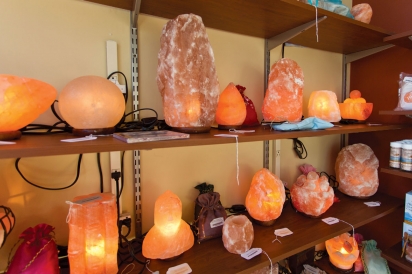Pass the Salt: A Multipurpose Mineral with Bountiful Benefits
As I peruse the nearly full canisters of herbs, leaves, and seasonings in my pantry, the recipient of my People’s Choice Award becomes glaringly evident. Salt, with its unmatched versatility, limitless shelf life, and instantaneous, flavor-enhancing powers, reigns supreme. Once used by our early ancestors to treat wounds and preserve food — particularly through methods of pickling, fermenting, and curing — this primitive brine has traveled hundreds of centuries to become the vital culinary component it is today. While its palate-pleasing properties are evident, salt plays a crucial role in our physical health, as well. Beyond the shaker, it serves as our primary source of sodium, an essential nutrient that helps to regulate fluid balance, muscle contraction, heart activity, and metabolism. Beyond the kitchen, a recent emergence of “salt cave therapy” rooms in the U.S., including one right here in Pittsburgh, has cultivated an entirely new understanding of salt’s medicinal effects on the body when inhaled into the lungs. Determined to understand this mystery mineral, we asked four local salt specialists for the facts. Trust us: they’re anything but flaky.
SALT ESCAPE
“This is as light as it gets in here,” whispers Peace, Love & Zen Holistic Wellness Center owner Susan Coe, ushering the Edible Allegheny team into what feels like another dimension. I note the pleasantly balmy climate; airy, tranquil music; and invigorating, salt-noted aroma, wondering if we’ve somehow teleported to the tropics. From the gently heated floors to the star-dusted ceiling, we’re surrounded by eight tons of Himalayan salt, imported from Pakistan and transformed into the first and only room of its kind in Pittsburgh. “It’s not uncommon for people to fall asleep in this salt cave,” Coe says with a laugh.
While the cave itself is less than two years old, its purpose has been around for centuries, most notably in Eastern Europe. Halotherapy, also called Himalayan salt cave therapy, uses a Halogenerator to grind up and pump salt into the air of a man-made salt cave, ultimately recreating the same type of air found in natural salt mines. Breathing this air into the lungs, Coe tells me, has been known to alleviate the symptoms of upper-respiratory ailments like asthma, allergies, sinusitis, COPD, bronchitis, common colds, and even headaches and migraines. “Himalayan salt contains 84 trace minerals that our bodies need to survive,” Coe explains. “It’s also an anti-inflammatory, so it’ll naturally clear up and dry out any congestion you might have.” The concept of salt cave therapy is thought to have originated in Poland, where salt miners were found to be generally healthier than the rest of the population.
Coe, whose “journey of wellness” inspired her to open a Himalayan salt cave of her own, says that the therapy has made a significant, positive impact on her health. “Generally, I don’t suffer from upper-respiratory issues, but I will tell you this: I’ve come into the cave with headaches, and I’ve walked out without them. It’s really powerful.” All health issues aside, Coe recommends the 45-minute halotherapy sessions to anyone looking to relax and de-stress. “It’s such a cleansing environment,” she says. “The experience is so good for your mind, body, and soul.” Leslie Bonci, director of sports nutrition at UPMC’s Center for Sports Medicine, encourages those in pain to give halotherapy a try, stressing that the cave’s effects — while powerful — are not permanent. “[Salt cave therapy] is a temporary relief, but there’s nothing wrong with that,” she says. “People should be doing whatever it is that makes them feel physically better.”
AGAINST THE GRAIN
A Himalayan salt cave session may relieve your illness, but unfortunately, simply eating that salt won’t do your common cold much good. Instead, Himalayan salts, and others like them, offer more of a culinary benefit. As Steel City Salt Company owner John Tarallo explains, Himalayan salt belongs to a class of unprocessed, “gourmet” salts, also called unrefined salts. These salts — varieties include Sicilian, Hawaiian, Peruvian, Fleur de Sel, and sea salt, to name a few — are harvested naturally, and may contain traces of essential minerals like magnesium, potassium, and iron. An iodized table salt, on the other hand, is usually processed and void of minerals.
Still, despite the presence of essential minerals in unrefined salts, most nutritional experts agree that there isn’t actually much of a difference between the two. “The body isn’t sensitive enough to know the difference between [refined and unrefined salts],” says Bonci. “A gourmet salt might have a more distinct taste, but at the end of the day, it’s still salt.” In fact, on a gram-for-gram basis, unrefined salts and table salts contain exactly the same amount of sodium, according to Elizabeth Ruder, assistant professor at the University of Pittsburgh’s School of Health and Rehabilitation Sciences. “Unrefined salts do contain minerals not found in refined salts, but they’re found in extremely small quantities that are too small to meet your nutritional needs,” she explains. Bonci adds that certain gourmet salts, like sea salt, tend to taste more “intensely salty” than their refined counterparts, causing us to consume less of them in a single serving.
Taste-wise, gourmet salts are characterized by their unique flavors and textures, and can possess different “mouth feels,” depending on how large their natural crystals are. And, while they aren’t necessarily healthier for us, they seem to give our food more zest than a table salt would. Tarallo, an avid cook, imports his gourmet salts from places all over the world — ranging from France, to Bali, to Hawaii — and suggests experimenting with the different varieties to find your favorites. “The table favorite is the Himalayan Pink Salt. Very smooth taste and finish, and perfect for cooking,” Tarallo says. “But, if you’re looking for crunch, try the Bali Pyramid Salt, which has a higher moisture content.” Like Coe, Tarallo also offers a variety of Himalayan salt lamps, in addition to salt shot glasses (“pour a shot, and use the salted tequila to make a margarita!”) and Himalayan salt slabs, which are used to sear and season food simultaneously.
WHEN TO SAY WHEN
For someone with a generally healthy lifestyle, an occasional sprinkle of salt on those Brussels sprouts probably won’t cause any harm. However, in our world of fast food chains, microwaveable dinners, and misleading nutritional labels, consuming more sodium than you need is actually quite easy to do. Unfortunately, high sodium levels are not something to take lightly. With increased sodium intake comes elevated blood pressure, and with that comes a whole host of health risks: stroke, heart disease, and kidney disease, among others.
Currently, the U.S. government’s Dietary Guidelines for Americans caps our max sodium intake at 2,300 milligrams per day, which is a challenge, considering that there’s roughly that much sodium in just one teaspoon of salt. Says Ruder, “Most of the sodium in our diets comes from sodium that’s already inherent in the foods we eat regularly — not from the salt shaker. But, if you really want to lower your sodium, the best way would be to look at the composition of processed foods in your diet.”
In addition to limiting heavily processed foods, some alternative methods of lowering sodium include: learning how to interpret and be more aware of nutrition facts panels; increasing fruit and vegetable intake; trying to be more “salt-savvy,” i.e., taste-testing your food first before adding more salt; and getting creative in the kitchen. “Instead of always reaching for the salt shaker first, try something different,” suggests Bonci. “A hint of pepper, herbs, or flavored vinegars can also give fabulous tastes to our food.”
Peace, Love & Zen Holistic Wellness Center, 6023 Broad St., East Liberty. 412.661.0777. Steel City Salt Company, steelcitysalt.com. University of Pittsburgh, pitt.edu. UPMC, upmc.com.






